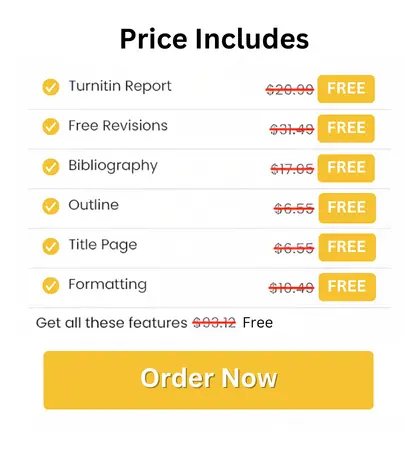
GDECE103 Language and Literacy in the Early Years Report 2 Sample
Task description:
Develop a set of 4 recommendations for early years educators, parents, and caregivers to support literacy development in children up to age 5. Your recommendations should include example activities and rationales based on relevant theory and research found in the academic literature and key policy documents. Your recommendations should also include consideration of diverse learners.
No introduction or conclusion required. An example recommendation has been included below, DO NOT use this same recommendation in your assignment.
Criteria:
• Clearly state 4 recommendations for practices that support early literacy development.
• For each recommendation, provide a rationale, drawing on theory and research.
• For each recommendation, provide examples of practice.
• Include recommendations for diverse learners where appropriate.
Word count: 2000 (approx. 500 words per recommendation)
Formatting: 12-point serif font (eg. Times New Roman). 1.5 or double line spacing.
Referencing: APA7 (please refer to this guide for referencing guidelines)
Solution
Recommendation 1: Promote Early Literacy through Shared Book Reading
Sharing books with toddlers in order to foster literacy skills as part of their natural development has been the mainstay of a language and literacy program for young children for many years now. The importance of parental engagement in the language development of children is still being proven by the research that focuses on the fact that it fosters vocabulary development, print awareness, and comprehension abilities (Furenes, Kucirkova & Bus 2021). An important task here is to stimulate the interest of children in interactive reading experiences right from early stages of life, as it is a pioneer for good literacy acquisition (Dowdall et al. 2020). The efficacy of shared reading between adults and children can be turned up a notch by making sure to choose really great kid's books with illustrations that are neat and meaningful, and subject matters that are of the right age level. The reading intonation of the instructor should elicit the participation of the children including questioning, prophecies, and to relate the story with their own experiences to enhance their critical thinking skills and comprehension. Dialogic reading approaches, including asking the kids to share the story on their own, or to ask questions about the characters, or the plot, is another method to make them work more with the story and understand it better.
Deciding about literacy resources and encouraging children to participate in sensory activities, such as telling them bedtime stories or reading books that cover children's interests will contribute positively to the existing hobby of reading and encourage them to see reading as essential to their daily life. Moreover, by demonstrating how to read smoothly and also by paying attention to concepts that print is aided such as reading from the left, and aiming letters and words, a child develops basic literacy. To put it another way, the promotion of shared reading should always take into account the differing needs of the students. Supports the development of readers by facilitating reading of diversified literature that mirrors their cultural background, languages, and experiences which safeguards inclusivity and keeps them involved with their reading materials (Prince, 2023). Picture cues or signs for labelling emotions is a real help in terms of understanding for those children with language delays or hearing impairments. As a result, multilingual or bilingual books are important as they play a vital role in the development of language among kids with different linguistic backgrounds, thus making them feel they belong and have pride in their cultures (Bredekamp, & Joseph, 2023).
Thus, collective book reading is a potent weapon that can help in bringing a smart approach for the early literacy development of children. Educators can maximise the potential of literacy in children's lives by devising well-thought-out teaching approaches that cater to the varied learner levels. Parents and caregivers can also join in creating enriching reading environments that form the basis of future learning and achievements.
Recommendation 2: Enhance Phonological Awareness through Rhymes and Songs
Phonological awareness is a base for the early literacy development, which in its turn plays an important role in learning to read and write by children. Embracing rhyming and song as modalities allows young learners to gain not only phonemic awareness, murk perception and auditory discrimination skills but also other series of mastery (Farias-Gaytan, Aguaded & Ramirez-Montoya, 2022). Promoting literacy through music and keeping rhythm will add joy and fun to training children on phonological application. They will also create an environment where learning and teaching take place effectively.
What we usually see in real life is that using nursery rhymes, chants, and rhyming words that have repetitive patterns and rhyming syllables provides children with sounds within the language structure to explore and manoeuvre. Besides, using foggers, finger plays, rhyming games, and body movements increases rhythm capabilities and these lay a foundation for syllable segmentation skills that put the children on the way to phonological proficiency (Blasco-Magraner et al. 2021). Actions like "I Spy" syllable or "Rhyme Time" words help children to be able to perceive and generate words that coincide with shared phonemes, which is another type of phonological awareness.
Apart from that, making use of sound and visual aids such as household musical instruments and other props to accompany songs and rhymes gives children a chance to enjoy sensory games and sound making, hence expanding their language experiences (Fernández-Otoya et al. 2022). Phonological awareness is supported when children are involved in the activities such as singing songs at the time of transition or adding rhymes in circle time. The basic idea is the frequent exposure of these activities so that the children can apply the knowledge they gain in irrespective of the context (Golubovi? et al. 2022).
While dealing with diverse learners, it becomes imperative to give several changes and alterations to satisfy the requirements of individuals. Sign language, visual cues and gesture can ease comprehension and involvement for children with auditory disabilities or auditory process difficulties (Shrivastava et al. 2023). The value of sensory activities of touch and motion is also important for the sense of sound and rhythms, enabling the children with sensory processing variations to experience new things. Additionally, converting there-and-then song rhymes to include languages used at home by the kids helps develop them to be bilingual or multilingual which, in return, perpetuates inclusivity and charity with differences in language diversity (Bredekamp, & Joseph, 2023).
Thus, rhyme and song incorporation is one of the efficient methods of increasing phonological awareness in young learners and preparing them properly for a long literacy teaching process. Adopting a compelling range of learning strategies and promoting an inclusive culture can bring to rise conducive, rich literacy learning environments that empower inclusively learners for university assignment help.
Recommendation 3: Foster Emergent Writing Skills through Purposeful Activities
Facilitating foundational writing skills through intentional work is fundamental to start the literary life of children. Since with its findings recent studies keep demonstrating for kids that kind of writing engagement is of great significance. Through the use of writing in realistic conditions, adults can also foster a number of factors that are useful for literacy development, such as phonemic awareness, letter sound correspondence, and print awareness (Walker et al. 2020). An ideal writing centre may have a vast array of writing materials including pencils, markers, crayons and journals. In such a way children will creatively unravel their ideas via writing. Real world writing activities from the list making, writing letters, creating signs and journals, and putting down daily experiences allow the children to apply their indigenous skills. Furthermore, guided modelling onto letter formation and spelling assistance is provided and children are able to gain confidence and expertise in their writing skills. Praising and showing their written works is an effective strategy for kids to feel important and proud, and since it honours your literacy competences (Ardoin, & Bowers, 2020). It is also essential to weave writing experiences throughout the curriculum, for example, when children engage in art activities by drawing and labelling pictures, or when they adopt behaviours such as making up stories among the dramatic play setting.
The process of responding to the academic needs of these students, has to be spearheaded by the crafting of an elaborate plan, which guarantees equal allocation of resources and related supports designed to meet the needs of every individual learner. Giving kids special pencils with grips with which they can get a good grip or the use of speech-to-text software can enhance their participation in learning activities, especially those who could face the hurdles of the fine motor difficulties and physical disabilities (Ingvalson et al. 2020). Teachers through the easy deployment of these supportive devices can in effect build a platform for skills development and confidence boost enabling students to interact meaningfully in all literacy activities. Consequently, a sense of belonging and assimilation in a learning environment can be fostered.
Linguistic diversity and cultural inclusivity can be nurtured with a bilingually functional writing culture which involves the acknowledgement of young children's native languages. The promotion of the native language of the students or the one which they speak with their friends and family makes them feel not only that they are proud of themselves but also that they are moving on the right track with their literacy skills in a familiar and friendly context. Besides making other student's education worth a taste of learning when a class use multilingual policy, it also creates a sense of pride and identity.
Next, I note that adaptive differentiation is the key to providing emergent writing support which includes scribbles, drawings, and invented spelling as early as possible. This will give us an insight into children's developmental progression so that we can encourage positive attitudes towards writing (Bell et al. 2022). The recognition of these first forms of expression as the authentic and meaningful signs of learning contributes to a nourishing and affirming ground for development of literacy where children feel valued and prompted to proceed with the reading at their own speed. To begin the children's emergent writing pieces it's not only a proof that they have tried but also the notion that writing is a process of discovery and it's forgotten about the normative standards.
Cautiously, building emergent writing capabilities through focused activities are the base for helping the children to get literate skills. Through the creation of diverse writing situations and by reflecting the various needs of students, educators and caregivers can facilitate inclusive and educational settings that strengthen the self-esteem and the confidence of editing all the children who will eventually become the confident and proficient writers they are meant to be.
Recommendation 4: Cultivate Language Development through Meaningful Conversations
Telling important stories and communicating messages in a conversational way not only meets the requirement for young children to chalk up their learning achievements but also prevails with language they can use to navigate throughout their life without batting an eyelid. A lot of new articles were released and they all claim that the importance of children's language in various areas of growth and education has been proved (Lohndorf et al. 2021). Encouraging children to have deep and useful conversations has countless benefits among them including the importance of vocabulary, syntax, grammar and pragmatic language skills development. Through the provision of verbal communication in daily routines and activities like meal times, playdate and outdoor hikes, adults offer an immersion in linguistic stimuli that lead to a child's linguistic growth and development.
Furthermore, by applying open-ended questions and prompts from conversation to paint a broad scenario for young ones, thinking and communicating their ideas, opinions, or experiences could be easily encouraged, thus enhancing their communication skills. Scaffolding and support which provide that tailored to individual student needs turn out to be the other factor which to a large extent dictates the range of vocabulary and development of difficult syntax in children (Darvin, & Norton, 2023). Moreover, the use of group activities providing for communication and joint discussions, like storytelling circles, or role-playing games, or even challenging problem-solving exercises as part of the ESL classes not only helps with language acquisition but also serves in the development of social skills and everyone learning to cooperate with others.
It is important that modelling effective communication strategies is involved; the strategies can include active listening, providing constructive feedback, turn-taking and one should be respectful with the dialogue. The objective is promoting language acquisition (Dowdall et al. 2020). Adults as their role models endorse learning of language not only as a child but also make a culture of communicative competence within the class.
Addressing the diverse needs of different kinds of learners should be given priority while involving students in the designing of learning environments. Taking visual assistance, e.g. pictures, or schemes and schedules enables the child with language or Whittling problems to participate in the conversation (Darvin, & Norton, 2023). Allowing Language learners to come from various linguistic and cultural depictions to express themselves to others in the form of conversation leads to harmony hence bringing inclusiveness and cultural diversity. In addition to this, children with social communication difficulties can be equipped with conversational skills in an explicit instruction with modelling of turn-taking, topic maintenance and active listening by scaffolding (Dowdall et al. 2020). The way they participate and engage with others can then be promoted in meaningful interactions.
Consequently, interaction with others through meaningful conversations is an indispensable task in the development of kids' reading careers and their personal growth. Through cultivation of speaking-rich environments, demonstrating appropriate language patterns, and also taking into account the variety of students’ needs, educators and caregivers take a lead role in making our young children become comfortable communicators who are able to successfully address any task in school as well as in other spheres of life.
Reference List
Ardoin, N. M., & Bowers, A. W. (2020). Early childhood environmental education: A systematic review of the research literature. Educational Research Review, 31, 100353. https://www.ncbi.nlm.nih.gov/pmc/articles/PMC7348615/
Bell, N., Angwin, A. J., Wilson, W. J., & Arnott, W. L. (2022). Literacy development in children with cochlear implants: A narrative review. Australian Journal of Learning Difficulties, 27(1), 115-134. https://www.tandfonline.com/doi/abs/10.1080/19404158.2021.2020856
Blasco-Magraner, J. S., Bernabe-Valero, G., Marín-Liébana, P., & Moret-Tatay, C. (2021). Effects of the educational use of music on 3-to 12-year-old children’s emotional development: A systematic review. International journal of environmental research and public health, 18(7), 3668. https://www.mdpi.com/1660-4601/18/7/3668
Bredekamp, S., & Joseph, G. E. (2023). Effective practices in early childhood education: Building a foundation. Pearson. One Lake Street, Upper Saddle River, New Jersey 07458. https://eric.ed.gov/?id=ED633575
Darvin, R., & Norton, B. (2023). Investment and motivation in language learning: What's the difference?. Language teaching, 56(1), 29-40. https://www.cambridge.org/core/services/aop-cambridge-core/content/view/9867F8786C50C31C88D45B0009FC2383/S0261444821000057a.pdf/div-class-title-investment-and-motivation-in-language-learning-what-s-the-difference-div.pdf
Dowdall, N., Melendez?Torres, G. J., Murray, L., Gardner, F., Hartford, L., & Cooper, P. J. (2020). Shared picture book reading interventions for child language development: A systematic review and meta?analysis. Child development, 91(2), e383-e399. https://centaur.reading.ac.uk/80756/1/Dowdall%20Meta-anal%20FINAL%20%281%29.pdf
Dowdall, N., Melendez?Torres, G. J., Murray, L., Gardner, F., Hartford, L., & Cooper, P. J. (2020). Shared picture book reading interventions for child language development: A systematic review and meta?analysis. Child development, 91(2), e383-e399. https://centaur.reading.ac.uk/80756/1/Dowdall%20Meta-anal%20FINAL%20%281%29.pdf
Farias-Gaytan, S., Aguaded, I., & Ramirez-Montoya, M. S. (2022). Transformation and digital literacy: Systematic literature mapping. Education and Information Technologies, 27(2), 1417-1437. https://link.springer.com/article/10.1007/s10639-021-10624-x
Fernández-Otoya, F. A., Raposo-Rivas, M., & Halabi-Echeverry, A. X. (2022). A qualitative systematic literature review on phonological awareness in preschoolers supported by information and communication technologies. Education Sciences, 12(6), 382. https://www.mdpi.com/2227-7102/12/6/382
Furenes, M. I., Kucirkova, N., & Bus, A. G. (2021). A comparison of children’s reading on paper versus screen: A meta-analysis. Review of educational research, 91(4), 483-517. https://journals.sagepub.com/doi/pdf/10.3102/0034654321998074
Golubovi?, Š., ?or?evi?, M., Ili?, S., & Nikolaševi?, Ž. (2022). Engagement of preschool-aged children in daily routines. International Journal of Environmental Research and Public Health, 19(22), 14741. https://www.mdpi.com/1660-4601/19/22/14741
Ingvalson, E. M., Grieco-Calub, T. M., Perry, L. K., & VanDam, M. (2020). Rethinking emergent literacy in children with hearing loss. Frontiers in psychology, 11, 483371. https://www.frontiersin.org/journals/psychology/articles/10.3389/fpsyg.2020.00039/full
Lohndorf, R. T., Vermeer, H. J., de la Harpe, C., & Mesman, J. (2021). Socioeconomic status, parental beliefs, and parenting practices as predictors of preschoolers’ school readiness and executive functions in chile. Early Childhood Research Quarterly, 57, 61-74. https://www.sciencedirect.com/science/article/pii/S0885200621000569
Prince, N. (2023). Midwest Ecological Study Outlined the Neighbourhood Literacy Environment and the Inequitable Access Children Have to Books in Public Library Branches. Evidence Based Library and Information Practice, 18(1), 130-133. https://www.erudit.org/en/journals/eblip/2023-v18-n1-eblip07947/1098890ar.pdf
Shrivastava, R., Gupta, A., Nishant, Sharda, S., Das, D., & Goyal, A. (2023). Visual learning strategies for oral health promotion and treatment interventions in children and adolescents with hearing impairment–A systematic review. Special Care in Dentistry, 43(5), 597-610. https://onlinelibrary.wiley.com/doi/abs/10.1111/scd.12810
Walker, D., Sepulveda, S. J., Hoff, E., Rowe, M. L., Schwartz, I. S., Dale, P. S., ... & Bigelow, K. M. (2020). Language intervention research in early childhood care and education: A systematic survey of the literature. Early Childhood Research Quarterly, 50, 68-85. https://www.academia.edu/download/81179582/language-intervention-research-in-early-childhood-care-and-education.pdf




 81 Isla Avenue Glenroy, Mel, VIC, 3046 AU
81 Isla Avenue Glenroy, Mel, VIC, 3046 AU



